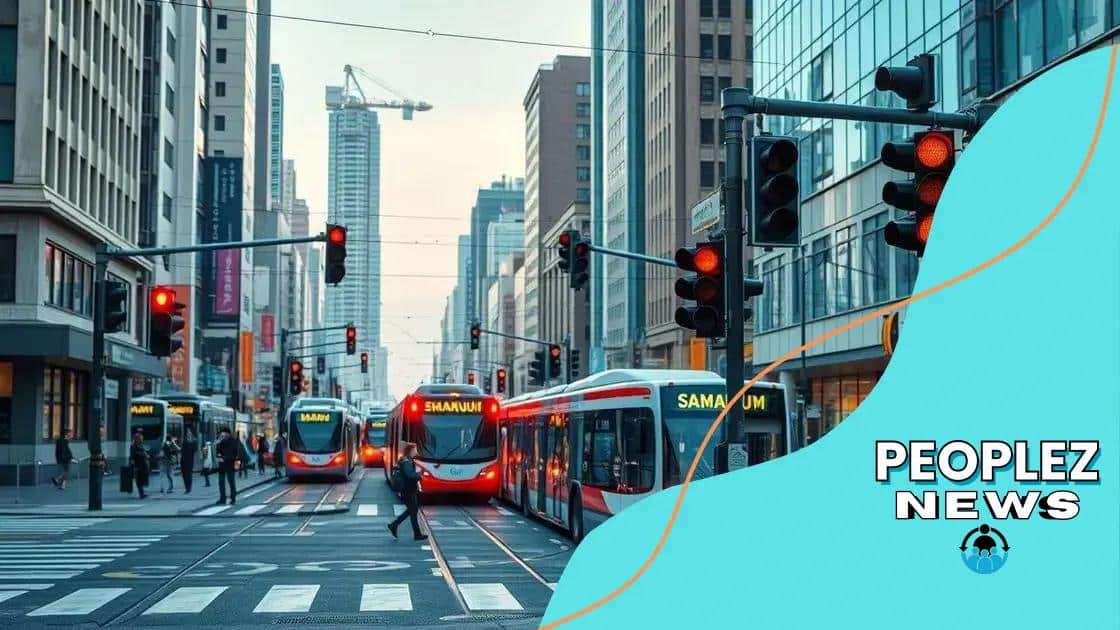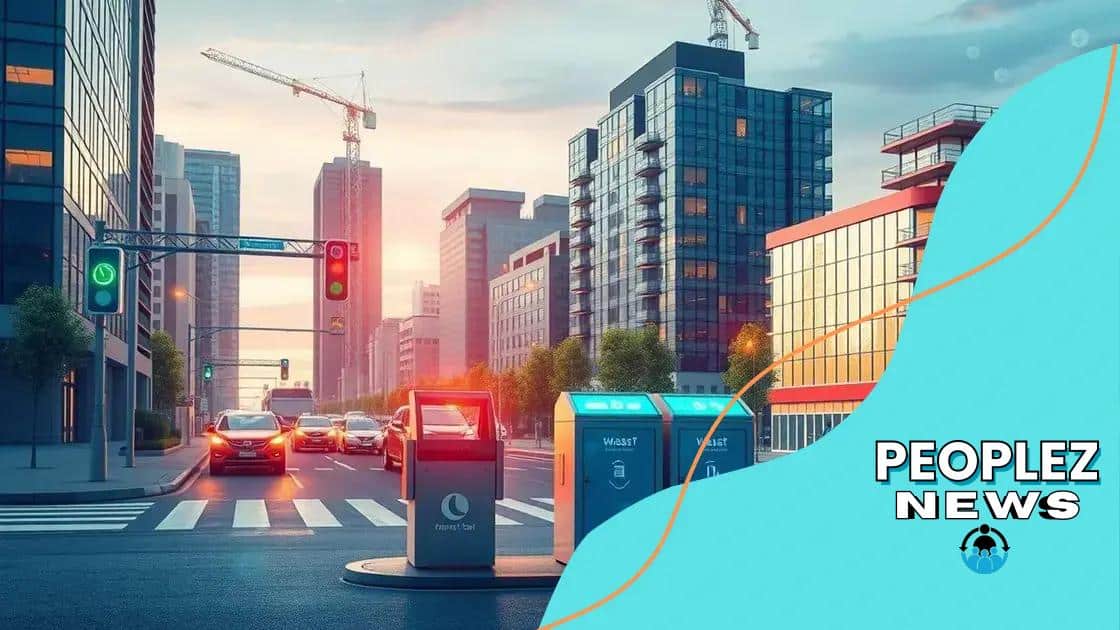Smart cities using IoT for enhanced living conditions

Smart cities using IoT enhance urban living by integrating technology for improved connectivity, sustainability, and public services, while addressing challenges like funding and data privacy.
Smart cities using IoT promise to revolutionize urban life, enhancing living conditions through innovation and connectivity. Have you ever wondered how technology could transform your daily experiences in the city? Let’s dive into this fascinating topic.
Understanding smart cities and IoT
Understanding smart cities and IoT is essential to grasp how technology shapes our urban experiences. Smart cities leverage IoT to create interconnected systems that improve quality of life.
One of the main aspects of smart cities is their ability to collect and analyze data. This data helps to optimize resources, thus enhancing functionality in various city services.
Key Components of Smart Cities
Each smart city focuses on fundamental components that drive efficiency:
- Smart transportation: Systems that help manage traffic flow using real-time data.
- Energy management: Intelligent grids that optimize electricity consumption.
- Public safety: IoT sensors that assist law enforcement in monitoring and responding to incidents.
- Waste management: Smart bins that signal when they need to be emptied, reducing collection costs.
These components not only make the city safer but also contribute to sustainability. For example, smart transportation systems reduce emissions by optimizing traffic flow and minimizing delays. People are encouraged to use public transport, which helps decrease the number of vehicles on the road.
Moreover, by implementing smart technologies, cities foster community engagement. Citizens can access information through apps, enhancing their connection to local services and resources. Imagine an app that alerts you to nearby events or public meetings.
The Role of IoT in Smart Cities
The role of IoT cannot be understated. Devices communicate with one another, creating a network that keeps everything in sync. For instance, smart street lights can adjust brightness based on pedestrian activity, saving energy while ensuring safety.
In conclusion, understanding smart cities and IoT reveals how technology can create vibrant, efficient urban environments. As we look ahead, these innovations promise to enhance our living conditions significantly, making our cities not only smarter but also more responsive to our needs.
Key benefits of IoT implementation
The key benefits of IoT implementation in smart cities are numerous and impactful. Adopting IoT technologies can transform urban living by enhancing efficiency and sustainability.
1. Improved Efficiency
IoT devices can streamline processes in public services. For instance, smart traffic lights can adjust their timings based on real-time traffic conditions. This leads to fewer traffic jams and smoother commutes.
Moreover, in energy management, smart grids can monitor usage patterns and distribute electricity based on demand, reducing waste. The overall efficiency of city operations significantly increases with these systems in place.
2. Enhanced Sustainability
Another crucial benefit is sustainability. IoT applications can help cities manage resources more effectively. For example, waste management systems can optimize collection routes based on bin fill levels, lowering fuel consumption and emissions.
- Water conservation: Smart sensors can detect leaks and prevent wastage.
- Smart buildings: These can adjust heating and cooling based on occupancy, saving energy.
- Urban agriculture: IoT can facilitate better crop monitoring and resource management.
The integration of IoT fosters green initiatives and helps to achieve environmental goals while keeping costs manageable.
3. Increased Safety and Security
IoT also enhances public safety. Surveillance cameras equipped with AI analyze data to detect unusual activities, helping law enforcement respond quickly. Additionally, connected fire alarms and environmental sensors can alert residents of hazardous conditions.
Communities feel safer with these smart monitoring systems in place, as they provide timely notifications about potential dangers.
Furthermore, IoT can help during emergencies. For example, connected devices can provide essential data to first responders, allowing them to act swiftly and effectively.
Examples of IoT in urban environments

There are many exciting examples of IoT in urban environments that demonstrate how technology can improve city living. These examples highlight the integration of smart systems that benefit residents and enhance their quality of life.
Smart Transportation
One prominent application is in smart transportation. Cities are now using IoT sensors to monitor traffic flow. These sensors help adjust traffic lights in real-time, reducing congestion and minimizing wait times.
- Connected vehicles: These vehicles share data with each other and traffic systems to improve navigation and safety.
- Public transit systems: Buses and trains equipped with IoT technology provide real-time updates to commuters, enhancing their travel experience.
- Parking management: Systems that offer real-time parking availability can save drivers time and reduce emissions.
These smart transportation systems not only make commuting easier but also contribute to cleaner air by cutting down on idle times.
Smart Waste Management
Another fantastic example is smart waste management. IoT-enabled bins can monitor how full they are and signal when they need to be emptied. This system allows for more efficient waste collection routes, which saves time and reduces costs.
By utilizing this technology, cities can also promote recycling. Smart bins can sort materials and provide feedback on recycling habits in real time. This encourages communities to engage in sustainable practices.
Energy Management
Additionally, IoT solutions in energy management are prevalent. Smart meters allow residents to track their energy usage in real-time. This awareness helps people use energy more efficiently, lowering bills and reducing carbon footprints.
Moreover, cities are adopting smart grids that optimize electricity distribution. These grids can automatically react to energy demands, ensuring a balance between supply and consumption.
By implementing these IoT examples, urban areas not only become smarter but also more livable. Enhancements in transportation, waste management, and energy efficiency lead to a more sustainable future.
Challenges in developing smart cities
Developing smart cities comes with its own set of challenges. These obstacles can hinder progress and affect how effectively cities implement technology.
1. Funding and Investment
One of the biggest challenges in building smart cities is securing adequate funding. Many cities struggle to gather the necessary resources to invest in new technologies. This is often due to tight budgets and competing financial priorities.
Additionally, cities may need to collaborate with private companies to gain access to innovative solutions. Building partnerships can be complex, requiring clear agreements and shared goals.
2. Data Security and Privacy
Another major concern is data security and privacy. With the increase in data collected from various IoT devices, cities must ensure that sensitive information is protected. Breaches can lead to trust issues from residents who may worry about how their data is used.
To mitigate these risks, cities must invest in robust cybersecurity measures and educate the public about data privacy. Clear policies and transparency are essential to gain community trust.
3. Integration of Technologies
Integrating different technologies is also a significant challenge. Smart cities consist of numerous systems that must work together smoothly. This integration can be complicated, especially when dealing with legacy systems that are not designed to connect with modern technology.
Cities need to adopt standards and protocols that facilitate communication between devices. This requires collaboration among various stakeholders, including technology providers and government agencies.
4. Public Awareness and Engagement
Lastly, public awareness and engagement play a crucial role in the success of smart city initiatives. Many residents may not fully understand the benefits of smart technologies, leading to resistance. Cities need to invest in community outreach programs that educate the public about how these technologies improve daily life.
Building a supportive community is vital for the adoption of new systems. Residents are more likely to embrace changes when they see the positive impact on their lives.
Future trends in smart urban living
The future of smart urban living is promising, with advancements in technology shaping how we interact with our cities. As urban areas grow, integrating these technologies will become increasingly important.
1. Increased Connectivity
One major trend is enhanced connectivity between devices. Cities will deploy even more IoT sensors, allowing for seamless communication among different systems. This integration helps create a more efficient urban environment.
For example, smart traffic lights will not only adjust to real-time traffic conditions but also communicate with public transportation systems, optimizing overall traffic flow.
2. Sustainable Practices
Sustainability will be another key focus in smart urban development. Cities are increasingly adopting eco-friendly technologies to reduce their carbon footprint. This includes the use of renewable energy sources such as solar panels on buildings and smart grids to manage energy supply more effectively.
- Green buildings: New constructions will prioritize energy efficiency and environmentally friendly materials.
- Urban farming: Cities may integrate vertical gardens and rooftop farming, promoting local food production.
- Waste reduction: Innovations in waste management will aim to minimize landfill usage through recycling technologies.
These approaches not only improve living standards but also contribute to a healthier planet.
3. Enhanced Public Services
Public services will also see significant improvements. Smart cities will utilize advanced data analytics to provide better services to residents. For example, predictive analytics can help cities anticipate maintenance needs for infrastructure, preventing costly repairs.
Moreover, health services can leverage IoT devices to monitor public health trends and respond to potential outbreaks more quickly.
4. Greater Citizen Engagement
Empowerment of citizens will be a growing trend. As technology advances, residents will have more avenues to engage with their local governments. Smart apps will allow residents to report issues, access city services, and participate in community decision-making.
This connection fosters a sense of community and encourages activism as residents feel more involved in the governance of their cities.
FAQ – Frequently Asked Questions about Smart Cities and IoT
What are smart cities?
Smart cities use technology and IoT to improve urban living, enhancing connectivity, sustainability, and public services.
How does IoT enhance urban life?
IoT enables better resource management, real-time data collection, and efficient public services, leading to improved quality of life.
What challenges do smart cities face?
Challenges include funding, data privacy concerns, technology integration, and ensuring public engagement.
What future trends can we expect in smart cities?
Expect increased connectivity, sustainable practices, enhanced public services, and greater citizen engagement in urban planning.





